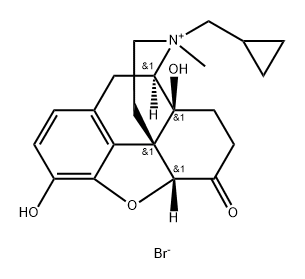メチルナルトレキソン臭化物

|
- ¥17000 - ¥246000
- 化学名: メチルナルトレキソン臭化物
- 英語名: Naltrexone methylbromide
- 別名:メチルナルトレキソン臭化物;メチルナルトレキソン臭化物 (JAN)
- CAS番号: 73232-52-7
- 分子式: C21H26BrNO4
- 分子量: 436.35
- EINECS:
- MDL Number:MFCD06407831
5物価
選択条件:
ブランド
- 富士フイルム和光純薬株式会社(wako)
- Sigma-Aldrich Japan
パッケージ
- 5mg
- 10MG
- 25mg
- 100mg
- 1ML
- 生産者富士フイルム和光純薬株式会社(wako)
- 製品番号M-227
- 製品説明Methylnaltrexone bromide solution 1?mg/mL in methanol, certified reference material, ampule of 1?mL, Cerilliant?
- 英語製品説明 1?mg/mL in methanol, certified reference material, ampule of 1?mL, Cerilliant?
- 包装単位1ML
- 価格¥17000
- 更新しました2024-03-01
- 購入
- 生産者Sigma-Aldrich Japan
- 製品番号SML0277
- 製品説明 ≥97% (HPLC)
- 英語製品説明Methylnaltrexone bromide ≥97% (HPLC)
- 包装単位5mg
- 価格¥22600
- 更新しました2024-03-01
- 購入
- 生産者Sigma-Aldrich Japan
- 製品番号SML0277
- 製品説明 ≥97% (HPLC)
- 英語製品説明Methylnaltrexone bromide ≥97% (HPLC)
- 包装単位25mg
- 価格¥114000
- 更新しました2024-03-01
- 購入
- 生産者Sigma-Aldrich Japan
- 製品番号1430724
- 製品説明 United States Pharmacopeia (USP) Reference Standard
- 英語製品説明Methylnaltrexone Peak Identification Mixture Cll United States Pharmacopeia (USP) Reference Standard
- 包装単位10MG
- 価格¥156800
- 更新しました2024-03-01
- 購入
- 生産者Sigma-Aldrich Japan
- 製品番号1430735
- 製品説明 United States Pharmacopeia (USP) Reference Standard
- 英語製品説明Methylnaltrexone bromide United States Pharmacopeia (USP) Reference Standard
- 包装単位100mg
- 価格¥246000
- 更新しました2024-03-01
- 購入
| 生産者 | 製品番号 | 製品説明 | 包装単位 | 価格 | 更新時間 | 購入 |
|---|---|---|---|---|---|---|
| 富士フイルム和光純薬株式会社(wako) | M-227 | Methylnaltrexone bromide solution 1?mg/mL in methanol, certified reference material, ampule of 1?mL, Cerilliant? 1?mg/mL in methanol, certified reference material, ampule of 1?mL, Cerilliant? |
1ML | ¥17000 | 2024-03-01 | 購入 |
| Sigma-Aldrich Japan | SML0277 | ≥97% (HPLC) Methylnaltrexone bromide ≥97% (HPLC) |
5mg | ¥22600 | 2024-03-01 | 購入 |
| Sigma-Aldrich Japan | SML0277 | ≥97% (HPLC) Methylnaltrexone bromide ≥97% (HPLC) |
25mg | ¥114000 | 2024-03-01 | 購入 |
| Sigma-Aldrich Japan | 1430724 | United States Pharmacopeia (USP) Reference Standard Methylnaltrexone Peak Identification Mixture Cll United States Pharmacopeia (USP) Reference Standard |
10MG | ¥156800 | 2024-03-01 | 購入 |
| Sigma-Aldrich Japan | 1430735 | United States Pharmacopeia (USP) Reference Standard Methylnaltrexone bromide United States Pharmacopeia (USP) Reference Standard |
100mg | ¥246000 | 2024-03-01 | 購入 |
プロパティ
融点 :237-239°C
貯蔵温度 :-20°C
溶解性 :H2O: ≥5mg/mL
外見 :powder
色 :white to beige
安定性: :Hygroscopic
貯蔵温度 :-20°C
溶解性 :H2O: ≥5mg/mL
外見 :powder
色 :white to beige
安定性: :Hygroscopic
安全情報
| 絵表示(GHS): |
 
|
|||||||||||||||||||||
|---|---|---|---|---|---|---|---|---|---|---|---|---|---|---|---|---|---|---|---|---|---|---|
| 注意喚起語: | Danger | |||||||||||||||||||||
| 危険有害性情報: |
|
|||||||||||||||||||||
| 注意書き: |
|
説明
The widespread efficacy of opioids in treating patients with moderate to severe acute and chronic pain is often accompanied by untoward side effects. In particular, opioid-induced bowel dysfunction is one of the more common and debilitating consequences afflicting up to 50% of patients. To counteract the peripherally-mediated adverse effects, opioid antagonists such as naloxone, naltrexone, and nalmephene are sometimes prescribed. The latest market entry exploits a strategic modification of naltrexone to lower its lipid solubility and increase its polarity: quaternization of the amine of naltrexone by methylation (methyl bromide) prevents crossing of the blood–brain barrier thereby creating an effective peripheral antagonist. Despite a loss of potency upon methylation, methylnaltrexone antagonizes opioid binding at m-opioid receptors with an IC50 of 70 nM. Its affinity for k-opioid receptors is approximately eightfold less (IC50= 575 nM) with no significant binding to d-opioid, orphanin, or non-opioid receptors. Methylnaltrexone bromide has been approved for the treatment of opioid-induced constipation in patients with advanced illness receiving palliative care.Regarding metabolism, methylnaltrexone bromide is eliminated primarily as intact drug (85% based on administered radioactivity) by slightly more renal than hepatic clearance.The most common adverse events were abdominal pain and flatulence followed by nausea, dizziness, and diarrhea.




